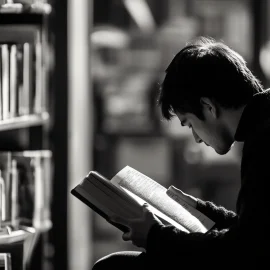

This article is an excerpt from the Shortform book guide to "The Diary of a Young Girl" by Anne Frank. Shortform has the world's best summaries and analyses of books you should be reading.
Like this article? Sign up for a free trial here .
How long was Anne Frank in hiding? What was life like in the Secret Annex?
Anne Frank spent over two years in the Secret Annex. While in hiding, Anne Frank kept a personal diary where she documented her life including her experiences and her fears.
Keep reading to learn about Anne Frank’s life in hiding.
Anne Frank’s Life in Hiding
The Annex had previously been used as a laboratory for Mr. Kugler. It was originally hidden away behind a series of doors and offices. After a few weeks, a bookshelf was installed in front of the door to further hide it from workers and police. The Annex was three stories and contained multiple small bedrooms, a kitchen/dining area, and a bathroom. Though the space wasn’t large enough to ensure total privacy, the residents had enough space to be on their own if they needed to be. The residents also used a private office in the building, but that office could only be used after hours as it wasn’t directly connected to the Annex and could be accessed by Mr. Kleiman and Mr. Kugler’s employees.
After arriving in the Annex, the Franks immediately began unpacking boxes they had sent in advance and got to work covering windows to avoid detection. They had to move quietly as the Annex shared walls with two other companies, and any sound could lead to dire consequences. Margot and Edith had to take significant breaks because they were overwhelmed by their new environment, but Anne and Otto worked consistently.
The van Daans arrived about a week after the Franks. They told the Franks that they had helped spread the lie that the Franks had fled the country to ensure that no one was looking for them. The family consisted of three people: Mr. van Daan, Mrs. van Daan, and their son Peter van Daan. Anne didn’t like them at first. She constantly fought with Mr. and Mrs. van Daan, who thought Anne had a bad attitude, and she thought that Peter was obnoxious.
Hobbies and Past Time
While in hiding, Anne Frank read a lot and always looked forward to receiving new books from their outside helpers. The children all received educational material and were required to study. The courses the children worked on included math, history, and languages.
In their daily lives, certain tasks had to be addressed creatively. For instance, bathing became difficult because they didn’t have a bathtub. When it was someone’s turn to bathe, they’d fill a washtub with hot water from the office, then carry the tub to a location in the Annex based on their comfortability and modesty. For example, Peter would bathe in the office after the employees had left despite the glass windows and door. He would just inform the other residents not to walk by for half an hour. Mr. van Daan, on the other hand, would fill the tub and carry it all the way up to his room to protect his privacy.
Anne constantly dreamed of freedom. She wanted to go outside and be around people again. In one example, she imagined herself and her father escaping to Switzerland and going shopping. She listed all of the things that she would buy and even set a budget for herself.
Internal Conflicts
During their hiding, Anne Frank’s arguments with her mother became more frequent. She believed that her mother didn’t understand her and thought that she went out of her way to shame her. Anne’s mother would often tell her that she was foolish and arrogant. For example, one time, they were talking about the proper term to refer to maids and domestic helpers. When Anne disagreed with her mother, her mother proceeded to tell Anne that she wasn’t a lady and that she spent too much time thinking about the future. The only time Anne believed that her mother was on her side was when they fought with Mrs. van Daan.
Mrs. van Daan was a constant source of conflict for everyone in the Annex. She and her husband would have intense screaming matches, she would try to flirt with Otto, and she and Edith constantly disagreed about how the makeshift home should be run. Mrs. van Daan also took it upon herself to constantly criticize Anne’s assertive and “un-ladylike” behavior. These constant critiques began to make Anne feel insecure.
According to Anne, Mrs. van Daan was melodramatic and always had to be the center of attention but wasn’t the best at defending her statements. She would sometimes leave conversations if she wasn’t getting her way. She constantly complained and committed petty actions that hindered the rest of the residents. For example, she would sometimes leave food to spoil on dishes instead of cleaning it to call people out for leaving messes.
While Anne had issues with many of the other residents in the Annex, she always turned to her father for support. She believed that he understood her, even if he felt obligated to side with the adults on certain matters. She couldn’t envision a world without him and loved him more than she loved her mother. She felt like he would actually listen to her despite her age.
External Threats
In addition to the constant disagreements inside of the Annex, the residents in hiding constantly worried about being discovered. Whenever someone was in the office or warehouse, the residents had to remain silent and calculate every action. Sometimes, these were expected visits such as a plumber coming to fix pipes in the office building. Other times, however, these were unexpected scares that caused fear to spike.
For example, Mr. Kleiman and Mr. Kugler once had a worker come in to fill the fire extinguishers, but he failed to tell the Annex residents. When the man started working, tensions rose and no one moved. A few minutes after the noise began, everything went silent. After a few minutes, someone began yanking and knocking on the bookshelf leading to the Annex. The residents thought that they had been discovered, but it turned out that it was just Mr. Kleiman. He told them that the hook holding the door had gotten stuck, which was why he had been unable to get in to warn them about the worker.
A combination of the internal conflicts and the fear of discovery took its toll on Anne’s emotional well-being. With the constant criticism, she began wondering if she actually was as terrible as all of the adults in the Annex said that she was. She felt torn because she knew that she was supposed to smile and take the abuse, but she wanted nothing more than to defend herself and speak out.
Gratitude and Holding Onto Hope
For Anne Frank, hiding in the Secret Annex was a blessing, rather than a curse. She’d often think about how fortunate she and her family were to have support and a place to hide. She sympathized with the people facing the Nazi threat directly and expressed gratitude that she was able to avoid that fate at the time. She compared her experience in the Annex to the people still out on the street:
- Where she had a quiet and safe place to live, others were being torn out of their homes and either sent to camps or left homeless.
- Where she had clothing and food, others were left in the cold with only a thin shirt and no way to get resources.
- Where she and her family could think about “after the war,” many were trying to survive on a day-to-day basis.
While her family wasn’t overly concerned with class or manners while in hiding, Anne Frank wondered if their way of life would ever return to normal. She thought that things such as using the same cloth for a table cover and not changing the sheets lowered their position in society.

———End of Preview———
Like what you just read? Read the rest of the world's best book summary and analysis of Anne Frank's "The Diary of a Young Girl" at Shortform .
Here's what you'll find in our full The Diary of a Young Girl summary :
- What Nazi occupation looked like from the perspective of a young Jewish girl
- How Anne Frank had some normal teenage experiences while in hiding
- How the hidden residents coped with the stress






